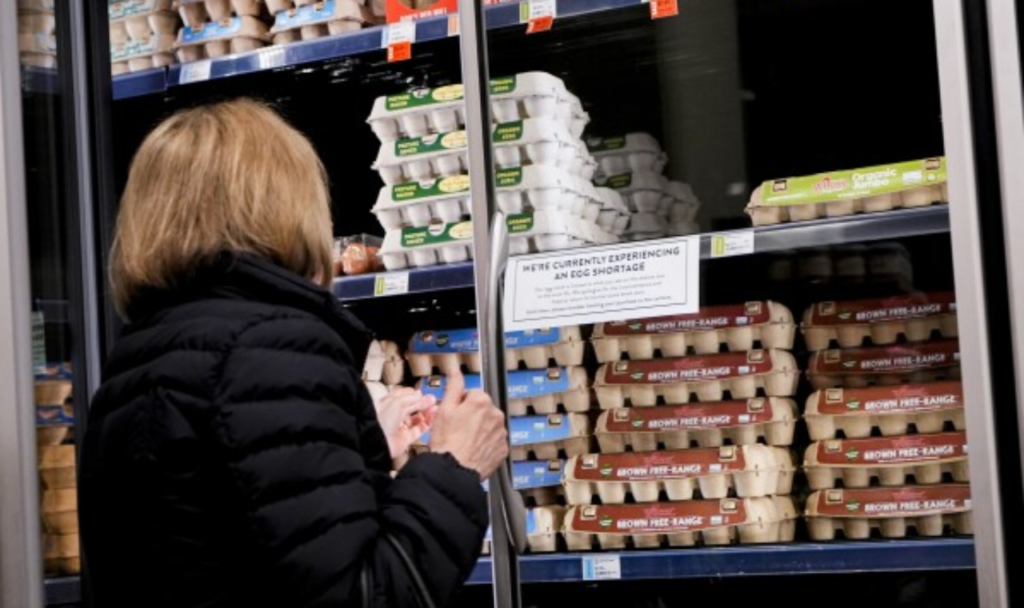In a statement that has generated significant public debate, former President Donald Trump recently claimed that egg prices in the U.S. are “getting too low,” even as the cost of a dozen eggs hit a record high of $6.23 in March 2025. This controversial assertion comes amid continued struggles for consumers and businesses coping with soaring food prices.
- Record-High Prices: A dozen eggs hit a record price of $6.23 in March 2025, with some regions seeing prices over $9 per dozen.
- Trump’s Controversial Statement: Former President Trump claimed egg prices were “too low,” sparking backlash amid high food costs.
- Bird Flu Outbreak: The bird flu outbreak has led to the culling of millions of egg-laying hens, causing a significant drop in supply.
- Supply Chain Issues: Ongoing supply chain disruptions and inflationary pressures from the pandemic have further raised egg prices.
- DOJ Investigation: The U.S. Department of Justice has launched an investigation into potential price gouging by egg producers.
- Consumer Adaptations: Many families are opting for alternative traditions, like decorating potatoes for Easter egg hunts, to avoid high prices.
The Record-High Egg Prices
Egg prices have reached unprecedented levels in recent months, marking the highest price ever recorded. According to data from the U.S. Bureau of Labor Statistics, the price of a dozen eggs surged to an average of $6.23 in March 2025, a substantial increase from the typical price of $1.60 just a few years ago. Some regions have even seen prices exceeding $9 per dozen at the retail level.
Several factors have been cited as the primary drivers of these elevated prices. The most significant contributor has been the ongoing bird flu outbreak, which has led to the culling of millions of egg-laying hens. This has drastically reduced the supply of eggs, leading to the skyrocketing prices. The outbreak of avian influenza, which affected poultry farms across the nation, has also triggered fears of further disruptions to egg production.
Trump’s Comments Stir Controversy
Despite the surge in egg prices, former President Trump recently sparked backlash when he described the current prices as “too low.” His comments came during a public event where he discussed the state of the American economy, notably focusing on food prices. Trump’s remarks have been criticized as tone-deaf, particularly as many families across the nation are feeling the strain of high food costs.
“The American people are suffering under the weight of these soaring egg prices, and yet some people say the prices are too low,” Trump said in his address. “We need to bring back prices that allow consumers to buy what they need without breaking the bank.”
Trump’s comments are likely an attempt to shift the conversation away from the role that previous policies may have played in the current crisis, but they have only ignited further discussion. Economists and analysts argue that such statements fail to address the underlying causes of the price surge, such as supply chain issues and the impact of disease on poultry production.

Factors Behind the Price Hike
The root causes of the spike in egg prices are multifaceted. The bird flu outbreak, which began in 2022, remains one of the most significant factors affecting supply. Over 43 million egg-laying hens have been culled to contain the virus, resulting in a sharp decline in egg production. This reduction in supply has forced prices to rise as demand for eggs continues to outpace available stock.
In addition to the bird flu, other contributing factors include supply chain disruptions and increased production costs. The inflationary pressures caused by the COVID-19 pandemic, followed by the global energy crisis, have led to higher feed prices for poultry farmers, further compounding the issue.
The U.S. Department of Agriculture (USDA) has worked to address these challenges, but experts agree that it will take time for the supply to stabilize. The USDA has also been working closely with farmers to implement biosecurity measures to prevent further outbreaks of avian influenza.
Investigations Into Price Gouging
In response to the persistent high prices, the U.S. Department of Justice (DOJ) launched an investigation into whether egg producers have been engaging in price gouging. Investigators are looking into whether producers intentionally limited the supply of eggs to artificially inflate prices.
Reports suggest that while wholesale egg prices have experienced a slight dip in recent months, retail prices have remained high. This discrepancy may be due to delays in passing on lower wholesale costs to consumers. Experts are questioning whether this is indicative of price manipulation or simply a lag in the retail market’s response to changes in wholesale prices.
The DOJ’s investigation is still ongoing, but many consumers are calling for greater transparency in pricing and more regulation of the industry. The Biden administration has expressed concern over the impact of high food prices on American families, particularly as many households are still recovering from the economic toll of the pandemic.
For more information on the DOJ’s ongoing investigation into price gouging, visit the official DOJ website.
Consumers Seek Alternatives
As the price of eggs continues to soar, many American families are searching for ways to adapt. For example, with Easter approaching, a tradition centered around egg hunts has been altered in many households. Some families have opted to decorate alternatives such as potatoes or other edible substitutes, hoping to lessen the financial burden during a time when many are already struggling to keep up with rising costs.
Small businesses, particularly bakeries, are also feeling the pinch. Cookie makers and others who rely on eggs for their products are facing higher production costs, which are pushing prices up for consumers. Several small business owners have voiced concerns over how Trump-era tariffs and policies are contributing to the inflationary pressures they face.
Looking Ahead: What’s Next for Egg Prices?
The future of egg prices remains uncertain. While some experts predict a gradual decline as the supply of eggs stabilizes, it is unclear when prices will return to more affordable levels. Many hope that government intervention and policies aimed at reducing production costs will help mitigate the financial strain on consumers.
To stay updated on the latest trends in egg prices and the USDA’s efforts to address the ongoing supply chain issues, visit the USDA website.
As the nation grapples with record-high egg prices, the debate surrounding food costs and economic policies is far from over. The path forward will likely involve a delicate balance of addressing public concerns, encouraging transparency in pricing, and ensuring that the agricultural industry can recover from the current challenges.
Conclusion
Trump’s recent comments on egg prices highlight the complex nature of the current economic situation. With millions of Americans grappling with soaring food prices, the question remains whether political figures are genuinely addressing the root causes of inflation or simply sidestepping the issue in favor of soundbites. As the investigations into price gouging continue and the public waits for relief, the nation’s relationship with food pricing may be forever changed.

Pankaj Kumar is a skilled content writer at OTE News, focusing on breaking news, technology, and socio-political developments. With a background in Mass Communication, he brings a balanced perspective to his articles, ensuring clarity and reliability. Pankaj has a knack for simplifying complex topics for readers.
In his free time, he enjoys photography, traveling, and experimenting with new cuisines. His curiosity and dedication to truthful reporting make him a valuable contributor to OTE News.




